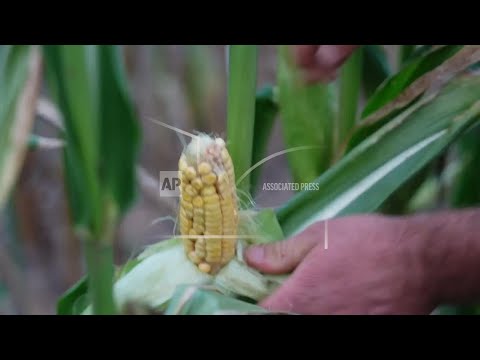(25 Aug 2025)
RESTRICTION SUMMARY:
ASSOCIATED PRESS
Paw Paw, Michigan – 18 August 2025
1. Wide of Robb Rynd walking through cornfield
2. Various of affected corn ear
3. SOUNDBITE (English) Robb Rynd, farmer:
"This year, we just, it’s hard to get excited to get out there and look at the corn because it’s not a great crop.”
4. Various aerial of affected corn field ++MUTE++
5. SOUNDBITE (English) Robb Rynd, farmer:
"It’s constantly hot all the time. It’s hot during the day, hot during the night, I mean, the corn’s never getting a break. I think some of these issues we’re seeing is the corn is growing faster than what the ear really wants to grow. And so the pollen, you know, so it’s not getting to the silks like it’s supposed to be.”
6. Various of affected corn tassels
7. Wide of affected corn field
8. Various detail of drought stress on leaves
9. SOUNDBITE (English) Robb Rynd, farmer:
"I think the corn can handle some drought, but when you get a drought rate at pollination, it’s really a crucial time for the corn. And I think that’s probably playing into some of the issues we’re seeing in these fields.”
ASSOCIATED PRESS
Nottawa, Michigan – 18 August 2025
10. Wide of Nicolle Ritchie inspecting corn in field UPSOUND (English) “Yeah, there’s another one.”
11. Detail of Nicolle Ritchie taking a picture of affected corn cob
ASSOCIATED PRESS
Paw Paw, Michigan – 18 August 2025
12. SOUNDBITE (English) Nicolle Ritchie, Michigan State University Extension agent:
"Very simply, no pollination, no corn. So since corn is a seed, you can’t get a seed without pollination. So as far as how it occurs, corn has these silks. If you’ve seen sweet corn at a grocery store, you’ve see those sticking out, and each silk is attached to one potential kernel. And each silk requires pollen individually. So the pollen comes from the tassel. And it’s like a little yellow dust that floats around and it touches the, lands on the silk, and from there it can fertilize the silk and the kernel starts to fill out eventually.”
ASSOCIATED PRESS
Nottawa, Michigan – 18 August 2025
13. Detail of Nicolle Ritchie removing part of husk for inspection
14. Cutaway of corn tassel
ASSOCIATED PRESS
Paw Paw, Michigan – 18 August 2025
15. SOUNDBITE (English) Nicolle Ritchie, Michigan State University Extension agent:
"We’ve had also very hot weather and heat is going to speed up crop growth. So like the tassel might mature faster and start putting out pollen. But if it’s really dry, those silks that are on the ear, those are driven by, basically by water pressure. So they’re counting on moisture to be able to keep growing. And if we don’t have adequate moisture that can really set them back or it can also just make it so that the pollen isn’t able to reach and fully fertilize them.”
ASSOCIATED PRESS
Nottawa, Michigan – 18 August 2025
16. Wide of Nicolle Ritchie inspecting corn field
17. Medium of affected corn
18. Detail and pan down of affected corn
ASSOCIATED PRESS
Paw Paw, Michigan – 18 August 2025
19. SOUNDBITE (English) Nicolle Ritchie, Michigan State University Extension agent:
"And you’ll have fully-developed kernels and then you’ll pockets of just nothing. But it’s a little empty white hole and it just goes directly to the cob. So obviously, that’s not great because you want to fill out your corn ear as much as you can. You only have so many ears in a field and you want good kernel count on them.”
20. Various of Robb Rynd inspecting corn plants in his field
21. SOUNDBITE (English) Robb Rynd, farmer:
22. Medium of Robb Rynd inspecting corn in his field
STORYLINE:
Find out more about AP Archive: http://www.aparchive.com/HowWeWork
Twitter: https://twitter.com/AP_Archive
Facebook: https://www.facebook.com/APArchives
Instagram: https://www.instagram.com/APNews/
You can license this story through AP Archive: http://www.aparchive.com/metadata/youtube/ccdfd2c31dbd41588858ad148b0fc322
Author: AP Archive
Go to Source
News post in August 30, 2025, 3:05 pm.
Visit Our Sponsor’s:
News Post In – News





